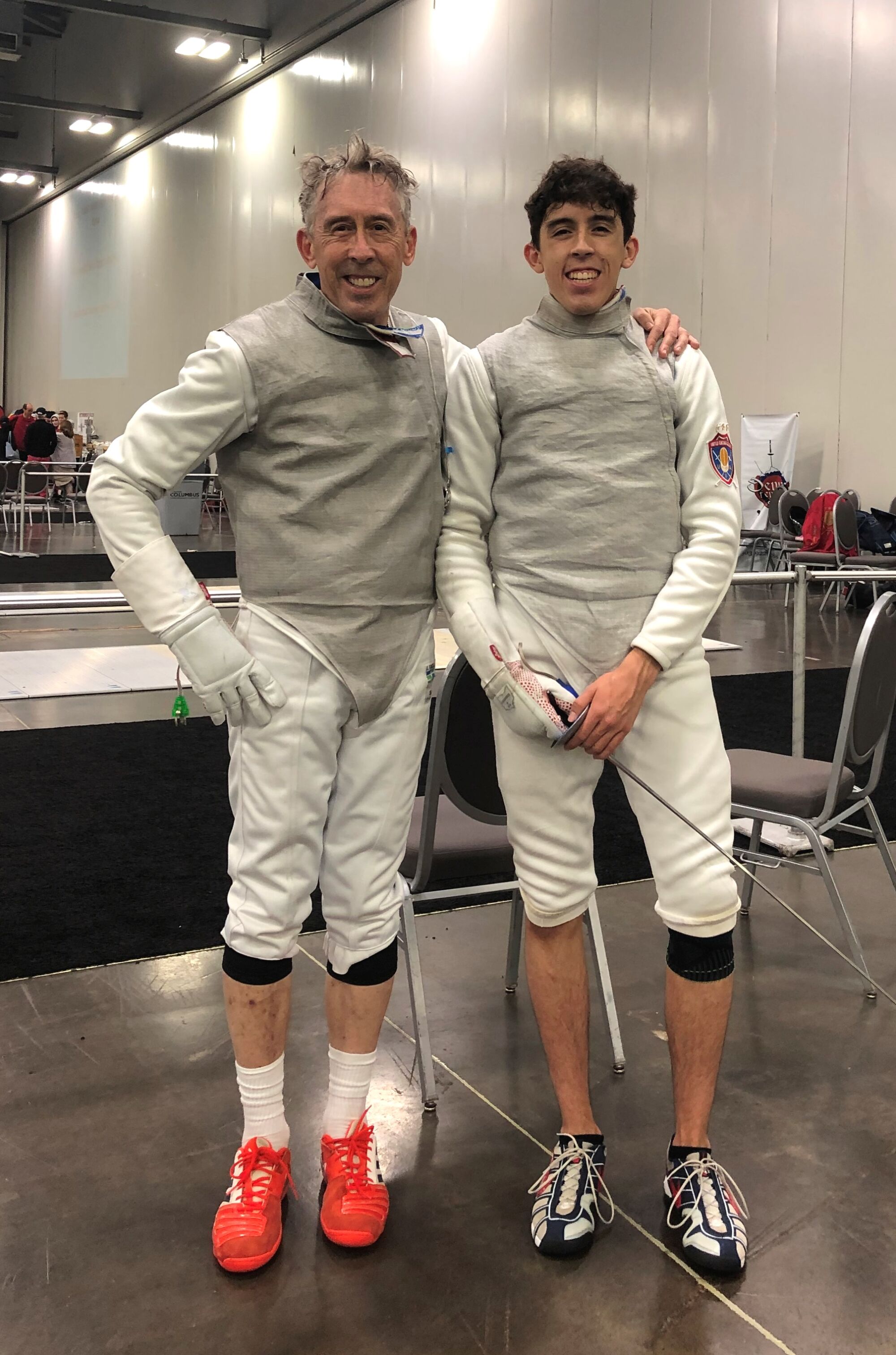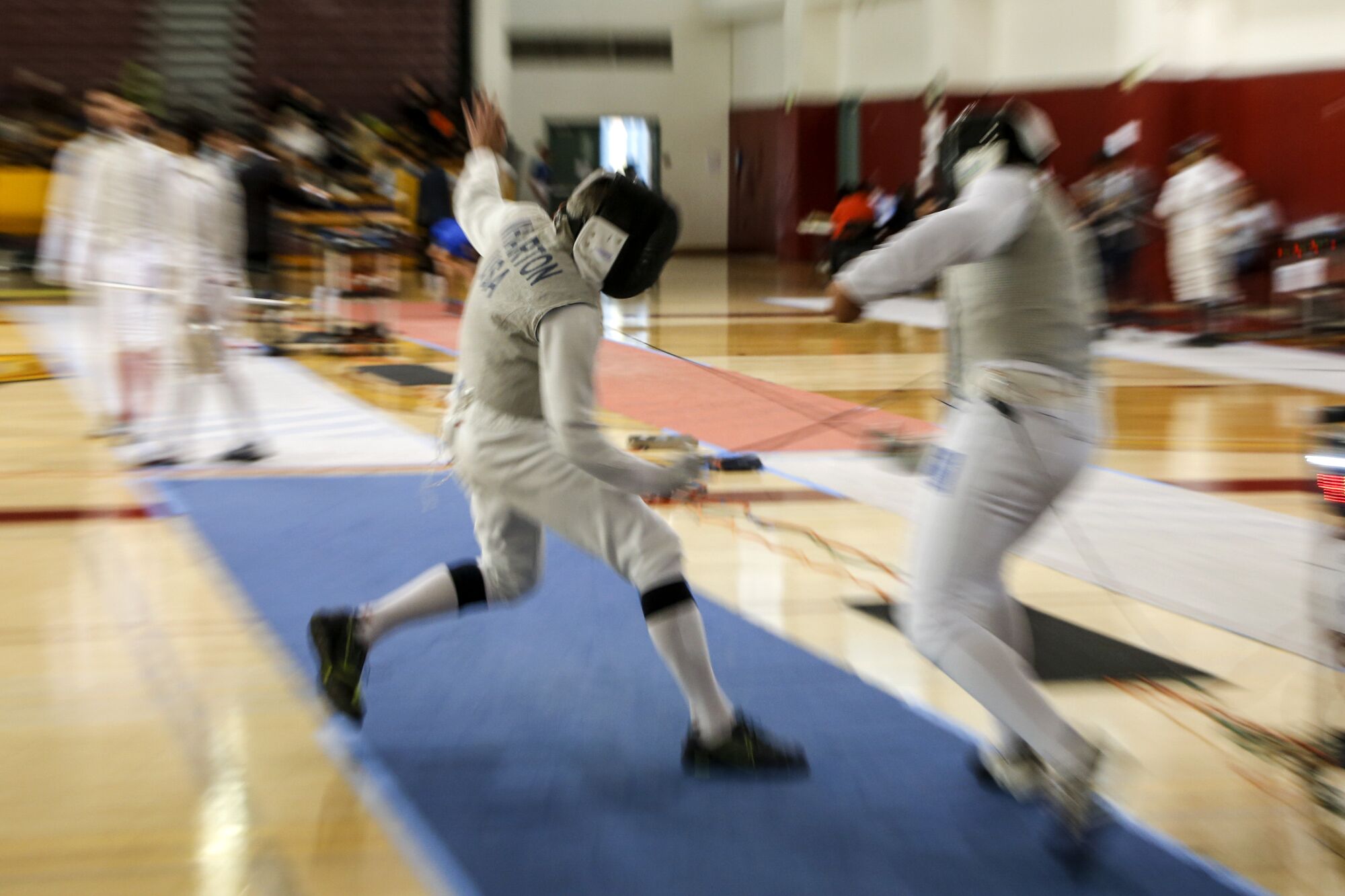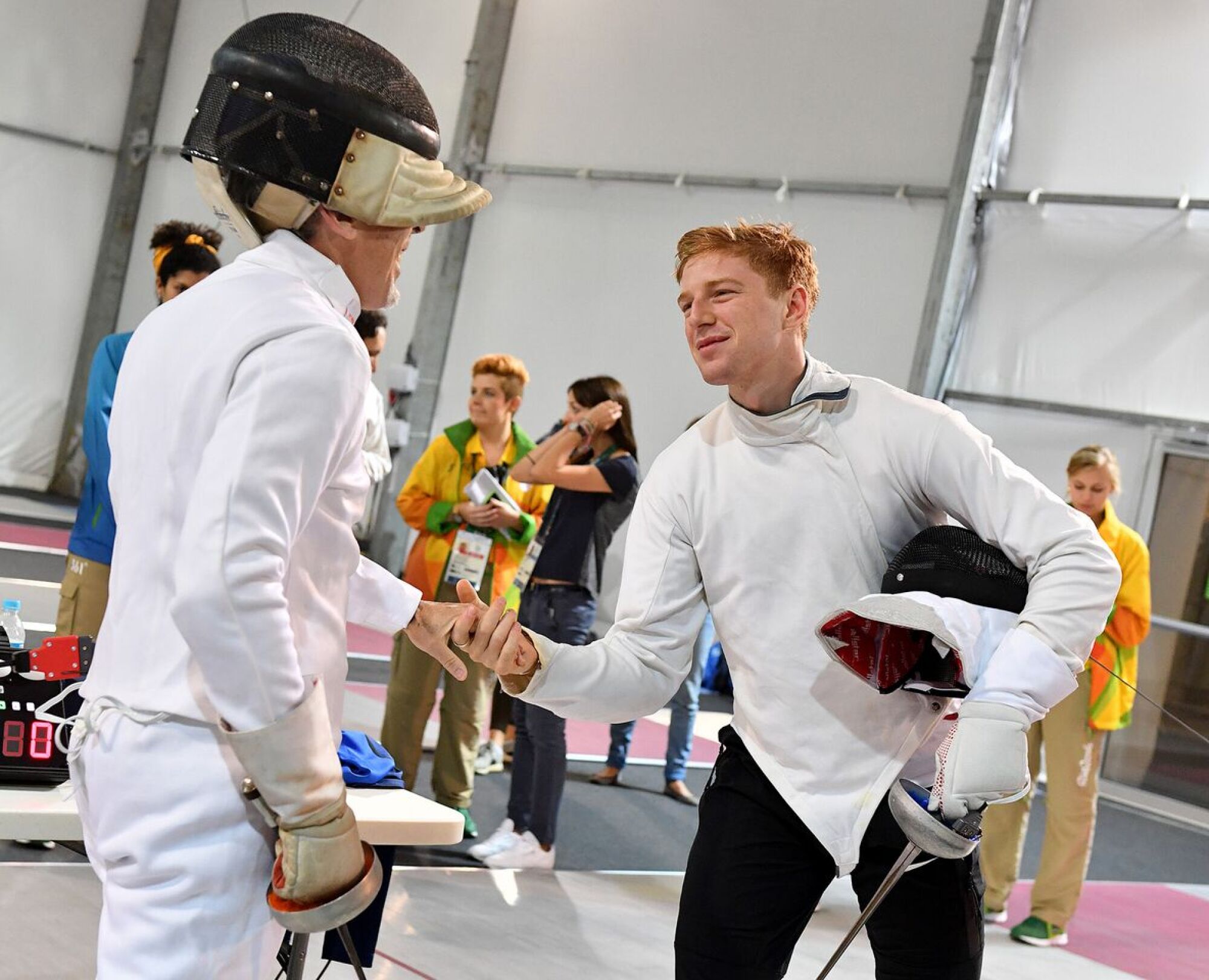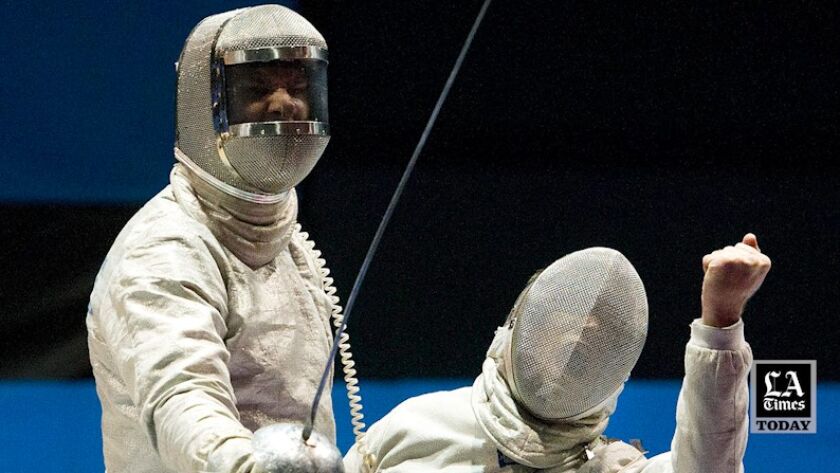What I’ve learned about getting older and finding your “why” from taking up fencing.

There is something about the sport of fencing that no one tells you. Not at first.
Sometimes it hurts.
Column One
A showcase for compelling storytelling from the Los Angeles Times.
Though the blades have no sharp points or edges, though you wear a uniform of heavy cloth, a direct shot to the chest or occasional whack on the forearm can deliver wincing pain.
Not that it matters in the heat of a bout, with adrenaline pumping, but the thought crosses your mind: Oh, that’s going to leave a mark. Sure enough, you later discover a few coin-sized bruises.
That is why new fencers, taking so many hits, are known as “pin cushions.” I learned the hard way by jumping into this sport at the ill-advised age of 55, suckered by a chance meeting at the London Olympics, a conversation that lured me into an arcane but devoted culture.
David Wharton competes against U.S. Olympian Race Imboden, right, during a media event at the 2016 Summer Olympics in Rio de Janeiro.
(Los Angeles Times)
This unexpected journey continued back home where, it turns out, Southern California has a connection to fencing beyond Errol Flynn and those old Hollywood swashbucklers. There is a network of clubs run by former European champions, a thriving high school league and a fierce competitive scene with sanctioned tournaments.
All of this had me struggling to learn blurry-fast technique while battling a parade of opponents younger and quicker than me, their jolting touches followed by something even more painful — triumphant screams and fist-pumps.
Six years on, I suspect that fencing has taught me a few things about my love of sports and growing older. It has surely forced me to ask questions. Why would I be foolish enough to start so late? Why subject myself to such a beating?
Also, why do I love it so much?

David Wharton, center, watches as he waits to compete in a senior foil event at the Southern California Division’s Centennial Tournament at Pasadena City College in November.
(Ringo Chiu / For The Times)
My job as the Olympics writer for the Los Angeles Times drew me into that London fencing venue in 2012, my first time seeing it live. A USA Fencing official introduced me to Tim Morehouse, a reigning silver medalist.
“Sit with him a while,” the official said.
For the better part of an hour, Morehouse did his best to cover the basics but ultimately said: “You just need to watch.”
Staccato advances. Flailing retreats. Explosive lunges. Somehow, this churning action was made of a thousand precise angles, like human geometry. Steel blades glinted and perfectly white uniforms glowed. It all seemed mysterious and, well, really cool.
That afternoon resulted in a brief newspaper article, nothing more, but fencing hibernated in the back of my mind for several years until my son started at West Hills Chaminade High, which had a decades’ old program. Though Zack played baseball, I asked for a favor.
“Baseball isn’t till spring,” I said. “Give fencing a try.”
After a week of practice, he said: “It’s OK.” The second week went better. Within a month, he was hooked.

David Wharton, left, and his son, Zack, at the 2018 USA Fencing Summer Nationals in St. Louis.
(Los Angeles Times)
The next four years saw him compete for his team against schools throughout Southern California, win medals at USA Fencing tournaments and travel the country for national championships and Junior Olympics. I loved watching him climb the ratings ladder while learning the best that sports can offer: Goal-setting, determination, resilience, confidence. I also grew a bit jealous.
This was my idea. I discovered fencing. Why did he get to have all the fun?
Age wasn’t the only excuse for remaining on the sideline. Fencing can be costly, what with lessons, travel and blades that tend to snap in half every so often. But then came the 2016 Summer Olympics in Rio de Janeiro.
The international fencing federation gathered some journalists, dressed us in uniforms and, after a brief introduction, held a quasi-tournament. Having fenced Zack in the backyard, I won my bouts and, as a reward, got to face U.S. team member Race Imboden. It was like having a catch with Mookie Betts or tossing a football with Matthew Stafford.
Leaving the arena that day, I knew what I had to do.
My boyhood was filled with tag football in the street and shooting hoops in the schoolyard. I went to San Francisco 49er games with my grandfather. My dreams revolved around playing sports. Any sport.
But as I grew older, my mother and I moved around. Nine schools in 12 years left time for only a season of Little League, some karate classes, a season of AYSO soccer. Finally, in high school, I strung together two years of tennis and was team captain.
With so little experience on the court, making the roster at top-ranked USC was a pipe dream. After a discouraging summer, traveling through small towns on a semipro circuit, I tossed my rackets in the closet and joined the campus newspaper.
Probably lots of people have stories like this, regrets about not getting picked for the lead in a school production of “Oklahoma!” or quitting that rock band in college. We move past it, get on with our lives.
I didn’t even cover sports early in my journalism career, working cops and courts, then entertainment. Skiing and surfing became new passions, though neither quite filled the gap that lingered from childhood.
Friends wondered why I didn’t write about the thing I loved most. After more than a decade in the business — the 1996 Atlanta Olympics were on television — I requested a transfer to sports. It took some persuading before my bosses agreed.
Though dreams recede, I suspect they never really go away.
Fencing can seem baffling. There are three weapons — epee, foil, saber — each with complex rules of its own. No need to get deep in the weeds; better to view the sport from a broader perspective.
Picture a ballroom dance, a couple floating across the floor, feet nimble, bodies in unison.
Or maybe a conversation. As one fencer advances, the other retreats. Each feint elicits a response, a defensive parry or a hop backward. Blades click with the hastening beat of an argument.

David Wharton, left, competes in the senior foil event at the Southern California Division Centennial Tournament at Pasadena City College in November.
(Ringo Chiu / For The Times)
Timing is everything as fencers search for “the moment,” probing, waiting for an instant when their opponent relaxes or leans off-balance, vulnerable to an attack. Perhaps I sensed all this in London, wanting to make my body move that way. Little did I know.
Fencers say you can spend a whole lifetime learning only half the sport. Progress can be frustrating, coming in fits and starts, but the challenge is addictive.
You begin by getting dressed, pulling on knickers and a cloth chest protector, navigating various straps and zippers, cinching up a thick jacket. I chose to fence foil, which means adding a silvery vest woven from stainless steel. I have to snake an insulated wire up my sleeve and down my back, plugging it into a floor cord that connects to the scoreboard so lights flash when I make a touch.
“I wanted to do what athletes do: Practice, get stronger and compete.”
The mask fits snugly, feeling strange, giving me tunnel vision, but also buttressing me against fears that inevitably arose as I stepped into one-on-one combat.
Every bout starts with an en garde stance: One foot pointed forward, the other sideways, knees bent in different directions, shoulders turned just so. It was the first of a thousand unfamiliar body positions that needed to become second-nature.
Each step must be measured, depending on circumstance and intent. Hands move to a different rhythm than the feet. The hardest trick is learning to “listen,” scuttling patiently back and forth, scouting the opponent’s tendencies.
Given my enthusiasm, the urge to play catch-up because of my age, I struggled to appreciate that, as with so many things in life, charging recklessly ahead doesn’t always work.
It is hard not to sense the hand of fate in all this.
Could it be pure coincidence that I wandered into the London venue? That my son’s high school had a team? That my city had so much fencing?
Early references to the sport in Los Angeles date back to 1860. By the 1920s, The Times was proclaiming that “Fencing Art is on the Boom” and the Southern California Division was holding its first tournament on the USC campus. European masters were moving here to coach the stars of films such as “Captain Blood” and “The Mark of Zorro.” The lineage of local Olympians runs from Ralph Faulkner, who made his first U.S. team in 1928, to current star Nick Itkin.
This unlikely heritage meant that my son could choose from several clubs near our San Fernando Valley home. He picked the United Fencing Academy, run by former Russian champions Vadim and Julia Ayupov. In the fall of 2016, when I dared to venture from the parent’s bench onto the strips, they gave me an unmistakable look.
“You are going to fence?” Julia asked.
Other parents had tried and drifted away. Fencing is not only rigorous but also excruciatingly personal. This isn’t like basketball, where you are surrounded by teammates, or tennis where the other player hits a passing shot from 30 feet away. Your opponent is in your face, no escaping the physical and emotional sting of his touch.

David Wharton competes in the senior foil event at the Southern California Division Centennial Tournament at Pasadena City College in November.
(Ringo Chiu / For The Times)
“My fencing gradually improved, though never as fast as I wanted, and there were more medals at low-level tournaments. On rougher days, I settled for small victories.”
Starting as an adult, I had to accept losing — and all that shouting — at the hands of teenagers. But it soon became clear this was a welcoming and supportive community, in the way of many niche sports.
My weekly regimen grew to include two nights at the United Fencing Academy, my wife patient enough for late dinners. I scrimped by learning to fix my own equipment, mend torn uniforms and get extra practice on the cheap at the Conejo Community Center, home of a small, devoted club founded decades ago by Dutch ex-pat Duris De Jong.
Though serious fencing injuries are rare, constant drilling and bouts triggered a stubborn ache that rotated from ankle to knee, from wrist to shoulder. Advil and daily stretching allowed me to pursue simple goals.
I wanted to do what athletes do: Practice, get stronger and compete.
On the morning of my first tournament, a novice event in Orange County, I sat in the car wrestling a flood of nerves that made my palms go sweaty, my legs feel dead. Was I about to make a complete fool of myself?
Life coaches and inspirational speakers talk about finding your “why” — your motivation, your true reason for doing something. It was a mental exercise I clung to as I began entering tournaments.
That first time went better than expected, ending with a bronze medal and a big smile, but advancing beyond the novice level put me at a clear disadvantage. With few age-group competitions on the schedule, I had to enter “opens” against those college and high school fencers.
The next few years were a roller coaster ride. My fencing gradually improved, though never as fast as I wanted, and there were more medals at low-level tournaments. On rougher days, I settled for small victories.
But not every achievement was related to winning, as fencing became a second family with lots of new friends. In my third season, I qualified for the 50-plus age group at the national championships, which meant traveling to St. Louis for a week with Zack, who was competing in the cutthroat junior division. How often do fathers get to share a sport and speak the same language with their teenage sons?
But something changed during the pandemic, during months of fencing only Vadim and a pal, Ryan, in an otherwise empty club. I began champing at the bit, worried that time was passing me by, my reflexes slowing as I turned 60.
When competitions resumed last fall, the results were dismal, one disappointing day after another. My “why” was bumping headlong into another truth: Nobody likes to lose all the time. As the season ended with a 40-plus event, I could not help wondering if it might be my last tournament.
Somehow, things clicked.
In a small field of opponents, most rated higher than me, I reached the semifinals and scored three straight touches to force sudden death, where a lunging coupe earned me the win. Then came a close final decided by two attacks in the last minute. I had my first gold medal and a sought-after national “E” rating.
“What do you know?” a friend and fellow competitor said. “All the stars aligned.”
It is a little embarrassing to admit how much that victory meant to me. At the very least, it succeeded in bringing me full circle.

David Wharton shakes hands with U.S. Olympian Race Imboden, right, during a media event at the 2016 Summer Olympics in Rio de Janeiro.
(Los Angeles Times)
There was a different vibe — more relaxed, more excited — as this season began with bronze at a regional tournament and a respectable finish in one of those opens. Things did not go as well at the Southern California Division’s centennial tournament in November but, as always, there were lessons to be learned.
By now I have grown accustomed to the aches and small bruises. Though winning still feels good and losing hurts equally as much — those pre-tournament jitters still hit me every time — I remind myself about what counts.
After all these years, I’m in the game.
Watch L.A. Times Today at 7 p.m. on Spectrum News 1 on Channel 1 or live stream on the Spectrum News App. Palos Verdes Peninsula and Orange County viewers can watch on Cox Systems on channel 99.





